What is pesto?
A pesto is basically a simple sauce made of blended flavorful greens, cheese, nuts and olive oil. The pesto that we all know about is basil pesto, but you can make a cilantro pesto, an arugula pesto, a spinach pesto, a kale pesto (don’t make that face!) or a pesto with any flavorful green. In fact, you could veer off the path of leafy green altogether and make a sun-dried tomato pesto, or blend some roasted red peppers for a roasted red pepper pesto. Pick your prominent flavor and then think about complimentary flavors.
Pesto also includes a nut of some kind – traditionally pine nuts, but you could use walnuts, hazelnuts, almonds, pistachios or any combination of nuts for a different flavor. Cheese is another common component to a pesto. Usually Parmesan cheese is used, but Pecorino Romano or another hard cheese could work instead, but it must be a hard cheese. You’ll find most pestos include garlic, although how much is very variable. I like to keep the garlic to a minimum in my pesto – just enough to flavor the sauce, but not so much that you end up tasting that flavor for the next three days. It’s easy to over-garlic foods and garlic cloves come in many different sizes, so use your best judgement and know that it’s ok to add half a clove of garlic if you prefer.
Finally, lemon juice, salt and olive oil make up the rest of the ingredients. Lemon juice adds some zip to the sauce and salt brings out the flavors of all the other ingredients. What type and how much olive oil you use is entirely up to you. You should use an olive oil with a flavor that you like – a bright green grassy flavor or a more mellow yellow olive oil if that’s what you prefer – and how much oil depends on how you plan on using the pesto. Pesto can be runny and pourable or thick and spreadable. There’s no wrong or right, just what works for what you’re making.
How to enjoy pesto…
Most often, pesto is a sauce for pasta. In fact, it’s one of the easiest pasta sauces to make and simply tossing some pesto with warm spaghetti, a little pasta water and perhaps another glug of olive oil can be a very satisfying meal. But you can also spread pesto on a sandwich, on a pizza, put a little in an omelet or even on grilled fish or a baked potato. There are really no limits to how you can enjoy it, but you can imagine how the consistency of the pesto changes with all these different applications. A pesto that is loose and pourable would be easier to toss with pasta, whereas using a loose and pourable pesto on a sandwich would not be ideal. Because it is easier to thin a pesto rather than thicken it, I like to make a pesto that is thick and then loosen it as I see fit based on what I’m going to do with it. Make sense? This pesto below is thick and spreadable. If I were to choose to use it on pasta, I could thin it with more oil or a little pasta water.
How do you make a pesto?
The word “pesto” is derived from the Italian word for “pound” or “crush” and the sauce was traditionally made with a mortar and pestle. This takes a little time as you first crush the garlic into a smooth paste, then add salt, pinenuts and the basil leaves, pounding with the pestle until smooth. While it does take time, I find that a pesto made in a mortar and pestle has the best consistency and smoothest taste. It may be because the ingredients are pounded rather than pulverized, letting their natural oils release and blend. These days, when everyone seems to be short on time, many make a pesto more quickly using a food processor or blender. If you’re short on time and have opted for mechanical help in making your pesto, there are a few rules to using a food processor or blender that helps make the task easier.
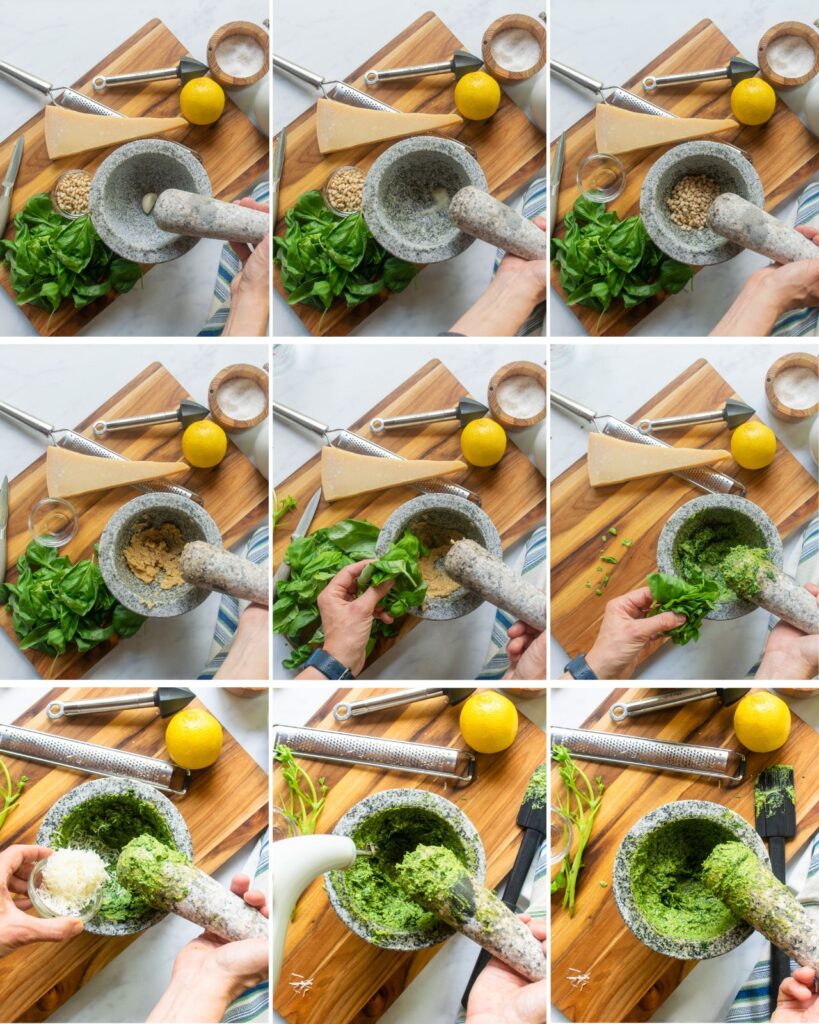
Dry first, then wet…
First of all, always blend dry ingredients before wet ingredients in a food processor.Dry ingredients will come in contact with the blade of the processor and bounce around the processor cavity encountering the spinning blade over and over again. Wet ingredients (or any moisture), on the other hand, cause the ingredients to stick to the side of the processor bowl and escape contact with the blade, requiring you to scrape down the sides of the processor constantly. So, add your dry ingredients, like nuts, cheese and garlic first.
Use the feed tube…
Food processors have a feed tube (and blenders have a hole in the lid) for a reason. It’s so you can add ingredients while the motor is running and the blades are spinning. This is effective for small objects like cloves of garlic because you can drop them into the processor and they will come into contact with the blade immediately and not get stuck under the blade. Start your processor and then add your dry ingredients.
Then basil…
Because basil and any leafy green has a water content, it’s best to add it after you have blended your other ingredients. You’ll find that once you’ve added the basil you will need to scrape down the sides of the processor bowl, but you can rest assured that your cheese, nuts and garlic have already been chopped effectively.

Then liquids…
Once the basil has been chopped, add your olive oil and lemon juice. You can add these ingredients through the feed tube as well so that they are distributed more evenly more immediately. Of course, you’ll be scraping down the sides of the processor here as well, but that’s inevitable. The color of your olive oil will have an effect on the color of your pesto. If you don’t want the pesto to turn more of an army green, try adding a handful of bright green spinach to the mix.

Finally… season.
The last step in making a pesto is seasoning it. Add salt to taste, but try to think about how you will be using the pesto before you season. Will it be accompanying other salty foods, or will it be the prominent flavor in your dish. Parmesan cheese is already pretty salty, so taste before you season, but do make sure you season. You may also find that it needs a little more lemon juice at this stage, so be prepared to add more as necessary.

Storage
You can keep pesto in the refrigerator for a week or you can freeze it for later. If you’re storing it in the fridge, press plastic wrap right down on the surface of the pesto to help prevent it from losing its color. If you decide to freeze your pesto, try using an ice cube tray and then transferring your frozen cubes of pesto to a sealable plastic bag. Being able to defrost just an ice cube or two of pesto allows you to make a quick pasta for one or two without having to defrost the entire batch. Just remember to give that ice cube tray a serious wash before using it again for ice!
Quick Notes:
- A pesto is a blended sauce made with a leafy green, nuts, cheese, garlic and olive oil.
- You can substitute ingredients to make different pestos.
- Instead of basil, try:
- cilantro
- spinach
- kale
- arugula
- mint
- sun-dried tomatoes
- roasted red peppers
- Instead of pine nuts, try:
- hazelnuts
- pistachios
- walnuts
- pecans
- almonds
- Instead of Parmesan cheese, try:
- Pecorino Romano
- other hard cheeses
- Instead of basil, try:
- Season carefully – Parmesan cheese is already salty and think about how you will use the pesto and if there are other salty ingredients involved.
- The word “pesto” is derived from Italian for “pound” or “crush” as it was traditionally made in a mortar and pestle.
- Pesto can be used on:
- pasta
- sandwiches
- pizza
- grilled fish or meats
- omelets and other egg dishes
- vegetables
- Store in the refrigerator with plastic wrap pressed down on the surface for up to a week.
- Freeze in ice cube trays and then transfer pesto cubes to a sealable bag for easy defrosting.

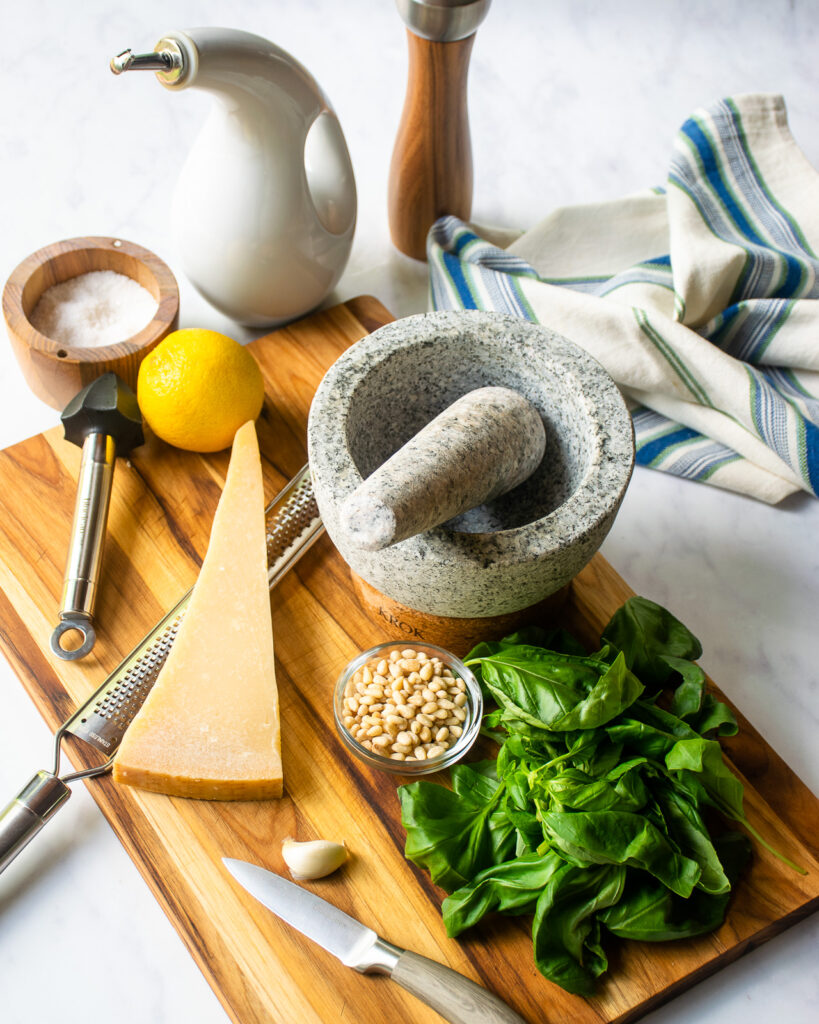
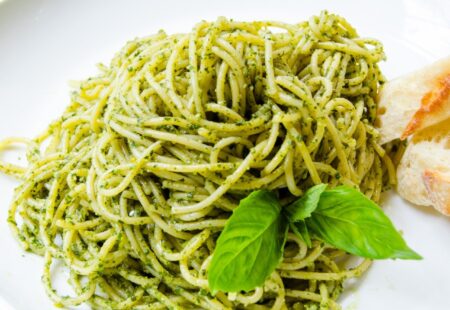


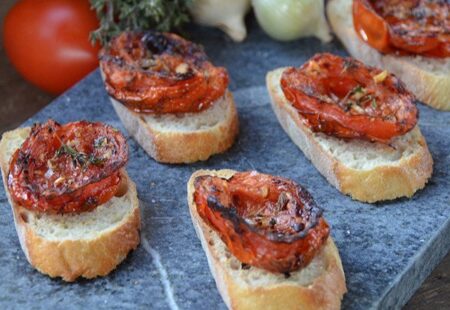
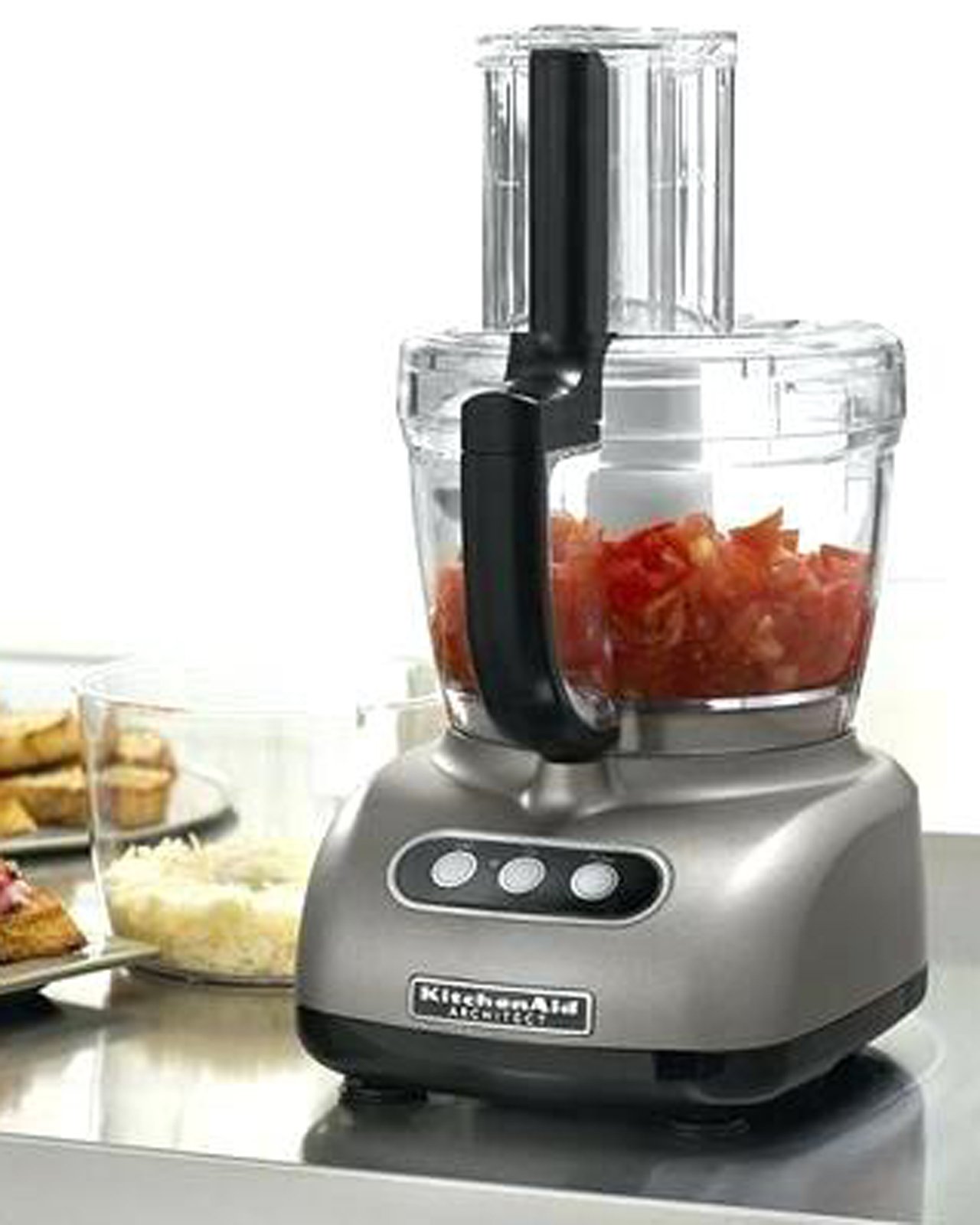





Absolutely love your recipes. Have you given any thought on doing a book on Keto recipes for us us keto dieters. I know it would be a big hit. I am excited to even think of you doing this. Thank you for all of your talents. Anne Tabor
could you take some of frozen pesto defrosted and mix in ricotta cheese instead of spinach for stuffed shells. i have used fresh but it would be great if i could do it during winter
Sure – you can use pesto instead of spinach. You might need a little extra cheese to make up for the lost quantity. You could also use frozen spinach instead of fresh spinach.